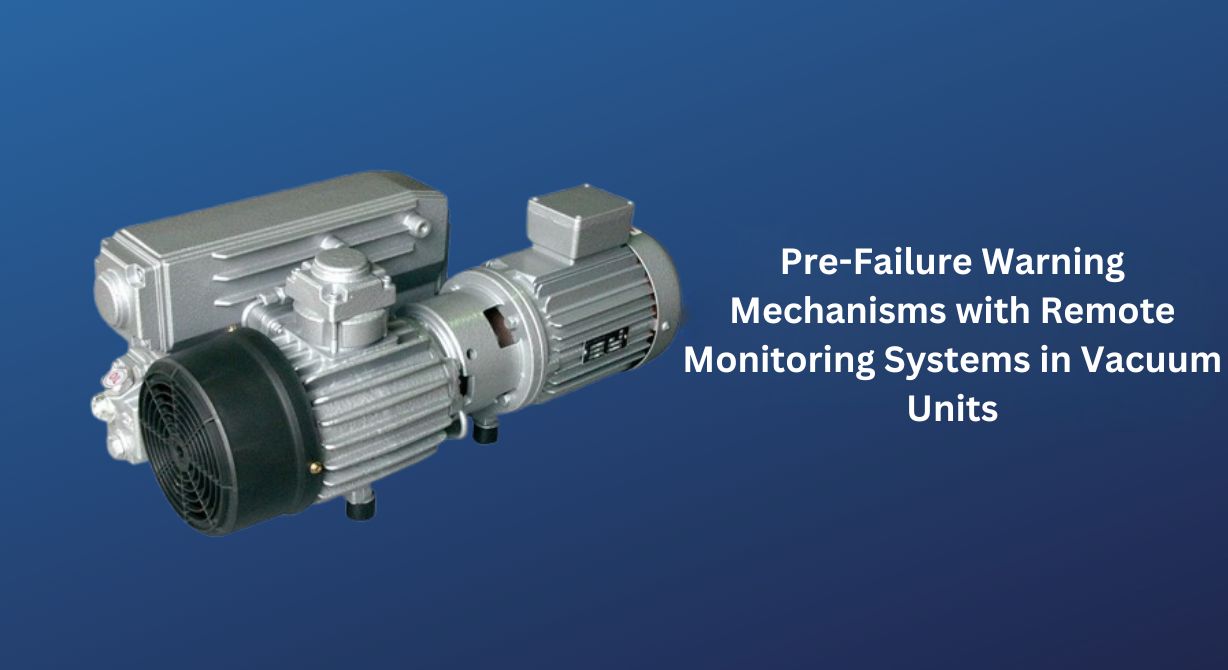Pre-Failure Warning Mechanisms with Remote Monitoring Systems in Vacuum Units
Table of Contents
- What Are the Key Pre-Failure Warning Signs in Vacuum Systems?
- A Guide to Implementing Remote Monitoring for Vacuum Unit Predictive Maintenance
- Essential Sensors for an Effective Vacuum Pump Pre-Failure Warning System
- Remote Monitoring vs. Manual Checks: Which is Better for Vacuum Unit Reliability?
- How to Interpret Data from Your Vacuum System's Remote Monitoring Dashboard
- The Top 3 Benefits of Integrating Pre-Failure Alerts with Your CMMS
What Are the Key Pre-Failure Warning Signs in Vacuum Systems?
In high-stakes industrial processes, from semiconductor manufacturing to chemical processing, the integrity of the vacuum system is paramount to operational continuity and product quality. Proactive monitoring for pre-failure indicators is not merely a maintenance strategy but a critical commercial imperative. The most fundamental warning sign is a gradual increase in the system's base pressure, indicating a deviation from its optimal vacuum level. This often points to a developing vacuum leak or a decline in the pumping efficiency, which can compromise process consistency and lead to costly scrap rates.
Another critical pre-failure metric is an abnormal rise in motor current or power consumption by the vacuum pump. This symptom frequently signifies increased internal friction or a higher load on the pump, potentially due to contamination, bearing wear, or fluid degradation. For oil-sealed pumps, such as those from Gücüm Pompa, a change in the oil's appearance—becoming cloudy or discolored—is a clear visual indicator of moisture ingress or particulate contamination. Similarly, unusual acoustic signatures, like knocking or grinding noises, and excessive vibration levels are direct mechanical warnings of impending component failure that require immediate investigation.
Advanced vacuum technology relies on precise diagnostics, where tools like a helium leak detector become essential for quantifying and locating even the smallest leaks that standard pressure readings might miss. The thermal signature of the pump is also a key data point; operating temperatures consistently above the manufacturer's specified range suggest issues with cooling, internal friction, or fluid breakdown. Implementing a robust predictive maintenance program that tracks these parameters allows for data-driven decision-making, shifting the maintenance paradigm from reactive to proactive.
The commercial benefits of addressing these pre-failure warning signs are substantial. It extends the mean time between failures (MTBF) for critical assets, directly reducing downtime and maintenance costs. For product managers, this translates to higher throughput and guaranteed product quality. Gücüm Pompa designs its systems with serviceability in mind, ensuring that early detection leads to simpler, less invasive repairs. Ultimately, understanding and acting upon these technical signals protects your capital investment and secures the reliability of your entire production line.
A Guide to Implementing Remote Monitoring for Vacuum Unit Predictive Maintenance
The transition from reactive to predictive maintenance represents a fundamental shift in industrial asset management, particularly for critical equipment like vacuum units. Implementing a robust remote monitoring system is the cornerstone of this strategy, enabling a data-driven approach to uptime and reliability.
A comprehensive guide to this implementation begins with the strategic placement of IoT sensors on the vacuum pump to capture vital parameters such as vibration, temperature, discharge pressure, and power consumption. This data acquisition forms the empirical foundation for all subsequent analysis, moving beyond scheduled servicing to condition-based interventions.
The true power of the system is unlocked through data analytics performed on a centralized platform, often leveraging cloud computing. By applying algorithms to the incoming sensor data, the system can establish a baseline of normal operation and identify subtle anomalies that precede failure. This capability for fault detection allows maintenance teams to address issues like bearing wear or cavitation long before they cause unplanned downtime.
For product managers and commercial leaders, the value proposition is clear and compelling. The primary benefit is a significant increase in operational efficiency. By preventing catastrophic failures, plants minimize production losses and reduce spare parts inventory costs. Furthermore, maintenance activities become planned and efficient, optimizing labor utilization and extending the mean time between failures (MTBF) for each asset.
The implementation guide provided by Gücüm Pompa details the integration of these monitoring solutions with existing control systems, ensuring a seamless flow of information. This integration facilitates condition monitoring across an entire fleet of vacuum units, providing a holistic view of plant health from a single dashboard. Decision-makers gain actionable insights, transforming maintenance from a cost center into a strategic advantage.
A well-executed remote monitoring strategy, as outlined in this technical guide, empowers organizations to achieve higher overall equipment effectiveness (OEE). It ensures that vacuum systems operate at peak performance, supporting continuous production and safeguarding profitability in demanding industrial environments.
Essential Sensors for an Effective Vacuum Pump Pre-Failure Warning System
The transition from reactive maintenance to a predictive maintenance strategy is critical for maximizing vacuum pump uptime and operational efficiency. An effective pre-failure warning system is built upon a foundation of essential sensors that continuously monitor key physical parameters, transforming raw data into actionable intelligence.
Vibration analysis is a cornerstone of this approach. Accelerometers mounted on the pump housing detect imbalances, bearing wear, and misalignment long before catastrophic failure. By establishing a baseline for normal vibration analysis and monitoring for deviations, the system can alert technicians to issues like cavitation or impending bearing failure, enabling planned intervention.
Complementing vibration data, temperature monitoring of bearings and motor windings is vital. Excessive heat is a primary indicator of friction, inadequate lubrication, or electrical problems. Continuous temperature tracking allows for the early detection of thermal anomalies, preventing degradation of lubricants and seals, which directly impacts the pump's mean time between failures (MTBF).
For oil-lubricated pumps, oil condition monitoring sensors provide a direct assessment of the lubricant's health. These sensors can measure moisture content, particulate levels, and viscosity, offering insights into internal wear and contamination. This data is crucial for optimizing oil change intervals and preventing wear-related failures.
The integration of these sensor streams creates a comprehensive condition monitoring platform. When combined with motor current analysis to detect electrical faults and load changes, the system provides a holistic view of pump health. This multi-sensor approach is the core of Gücüm Pompa's advanced monitoring solutions, enabling true predictive analytics.
The commercial benefits are substantial. By moving from scheduled maintenance to need-based interventions, facilities significantly reduce unplanned downtime and spare parts inventory. This proactive approach minimizes operational expenditure (OPEX) and extends the asset's service life. The data generated also supports asset lifecycle management, informing long-term capital planning.
A sensor-driven pre-failure system transforms the vacuum pump from a potential point of failure into a managed, optimized asset. Gücüm Pompa's engineered solutions leverage this sensor fusion to deliver unparalleled reliability and a strong return on investment for demanding industrial applications.

Remote Monitoring vs. Manual Checks: Which is Better for Vacuum Unit Reliability?
The debate between remote monitoring and traditional manual checks is central to modern industrial asset management strategies, particularly for critical equipment like vacuum units. While manual inspections provide a tactile, on-the-ground assessment, they are inherently reactive and prone to human error, often identifying issues only after a failure has begun to impact production. In contrast, a continuous remote monitoring system offers a proactive approach, transforming vacuum unit maintenance from a scheduled expense into a predictive, data-driven function that maximizes uptime.
The core advantage of a sophisticated monitoring solution, such as those offered by Gücüm Pompa, lies in its ability to capture and analyze real-time performance data. These systems track critical parameters like motor amperage, temperature, pressure levels, and vibration spectra. By establishing a baseline for normal operation, the system can detect subtle anomalies that would be imperceptible during a routine manual check, signaling the need for intervention before a minor issue escalates into a catastrophic failure. This shift is the essence of predictive maintenance.
From a commercial perspective, the financial implications are substantial. Unplanned downtime in a continuous process industry results in significant production losses. A remote system provides early warnings for components like bearings or seals, allowing for planned repairs during scheduled shutdowns, thereby avoiding expensive emergency calls and minimizing disruption. This level of asset reliability directly enhances operational efficiency and protects the bottom line, offering a clear return on investment.
Implementing a Gücüm Pompa remote monitoring platform also enhances operational efficiency by freeing skilled technicians from repetitive data collection tasks. Instead, they can focus on higher-value analysis and corrective actions guided by precise data. Furthermore, the historical performance data collected creates a valuable digital footprint for the equipment, aiding in root cause analysis of any faults and informing better future design and procurement decisions.
While manual inspections retain value for visual assessments and mechanical adjustments, they cannot compete with the granular, continuous insight provided by digital monitoring. For organizations prioritizing maximum asset reliability and operational cost-effectiveness, the integration of a remote monitoring system is not merely an upgrade but a strategic necessity. The data-driven intelligence it provides ensures that vacuum units operate at peak efficiency, safeguarding both productivity and profitability.
How to Interpret Data from Your Vacuum System's Remote Monitoring Dashboard
The transition from reactive maintenance to a predictive strategy is a core benefit of implementing a remote monitoring dashboard for your industrial vacuum systems. This technology provides a continuous stream of real-time operational data, transforming raw numbers into actionable intelligence for engineers and managers.
At the heart of the dashboard is the display of critical performance metrics, such as ultimate pressure, motor current, and temperature readings. Interpreting trends in these values is essential for effective predictive maintenance. A gradual increase in motor amperage, for instance, could indicate rising friction within the pump, signaling the need for an oil change or bearing inspection before a catastrophic failure occurs.
Understanding the system performance baseline is the first step in effective data interpretation. By establishing normal operating parameters for your specific application, the dashboard can be configured to generate automated alerts when key metrics deviate from this baseline. This enables a shift from time-based maintenance schedules to a condition-based approach, optimizing maintenance intervals and reducing unplanned downtime.
Advanced dashboards, like the one offered by Gücüm Pompa, go beyond simple gauges by incorporating data analytics tools. These tools can correlate vacuum level stability with process parameters, helping to identify inefficiencies. For example, analyzing power consumption against achieved vacuum can highlight opportunities for energy optimization, leading to significant cost savings in continuous-operation scenarios.
The financial implications extend beyond energy savings. A key metric for commercial decision-makers is total cost of ownership. By preventing unexpected breakdowns, extending component lifespan through timely interventions, and maximizing uptime, remote monitoring directly reduces operational expenses. This data-driven approach provides a clear return on investment.
For facilities with multiple vacuum pumps, the dashboard offers a centralized view for performance benchmarking. Engineers can compare the efficiency of identical units, quickly identifying underperformers for investigation. This facilitates proactive equipment diagnostics and ensures consistent process quality across production lines.
The ability to interpret dashboard data empowers teams to make informed, data-driven decisions. This transforms the vacuum system from a simple utility into a strategic asset, where every data point contributes to enhanced reliability, reduced costs, and improved operational efficiency.
The Top 3 Benefits of Integrating Pre-Failure Alerts with Your CMMS
Predictive alerts integration with a Computerized Maintenance Management System (CMMS) represents a fundamental shift from reactive maintenance to predictive maintenance paradigms. This synergy transforms raw equipment data into actionable intelligence, enabling maintenance teams to address issues before they escalate into catastrophic failures. At the core of this integration lies the seamless flow of condition monitoring data, such as vibration analysis and thermal imaging, directly into the CMMS work order management module. This automated data pipeline eliminates manual reporting delays and ensures that maintenance actions are triggered by precise, real-time asset health indicators rather than arbitrary time-based schedules or post-failure alarms.
One of the most significant benefits is the substantial extension of the mean time between failures (MTBF) for critical assets. Abnormalities such as bearing wear or misalignment are detected at the earliest stages, allowing interventions to be planned during normal downtimes and preventing excessive damage that would occur during a full failure. This proactive approach directly enhances asset reliability and operational uptime. For example, a pump monitored by a Gucum Pump system that detects a slight increase in vibration can have its bearings serviced over a weekend, avoiding an unplanned shutdown that could halt an entire production line for days, thereby preserving overall equipment effectiveness.
From a commercial perspective, this predictive capability delivers significant reductions in total cost of ownership. It optimizes spare parts inventory by transitioning from speculative stocking to just-in-time supply based on accurate failure forecasts. Additionally, planned repairs are typically less costly than emergency fixes, which often involve overtime labor, expedited shipping for parts, and secondary damage to adjacent components. The financial impact is clear: reduced capital tied up in inventory, lower labor costs, and minimized production losses.
The integration creates a robust feedback loop for continuous maintenance optimization. The CMMS becomes a centralized repository for failure precursors and their corresponding solutions. Analyzing this historical data allows organizations to refine predictive maintenance thresholds and strategies over time, moving from general OEM recommendations to data-driven maintenance plans tailored to their specific operational environments and usage patterns. This data-centric approach ensures maintenance resources are allocated with maximum efficiency and impact.

